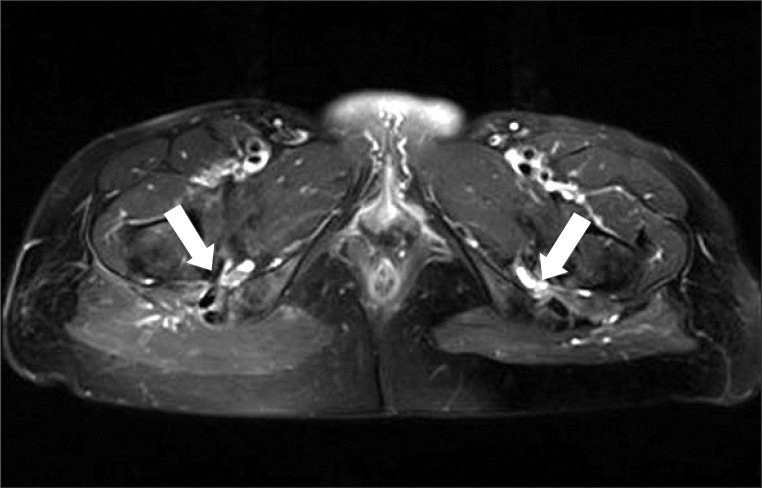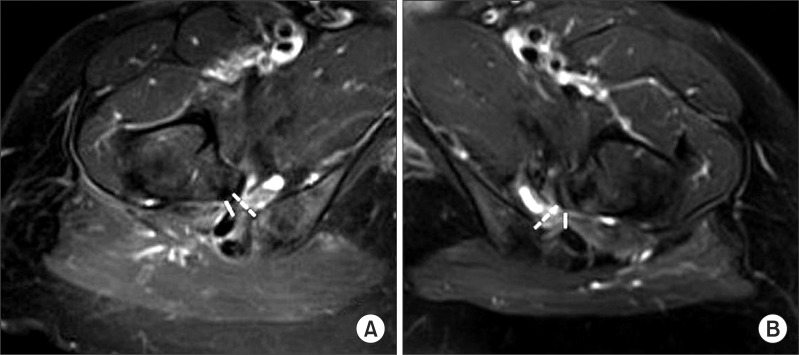Ann Rehabil Med.
2013 Feb;37(1):143-146. 10.5535/arm.2013.37.1.143.
Ischiofemoral Impingement Syndrome
- Affiliations
-
- 1Department of Rehabilitation Medicine, Keimyung University School of Medicine, Daegu, Korea. withjieunlee@hanmail.net
- 2Department of Radiology, Keimyung University School of Medicine, Daegu, Korea.
- KMID: 2266664
- DOI: http://doi.org/10.5535/arm.2013.37.1.143
Abstract
- Ischiofemoral impingement syndrome is known as one of the causes of hip pain due to impingement of ischium and femur, and usually correlated with trauma or operation. We report a rare case of ischiofemoral impingement syndrome that has no history of trauma or surgery. A 48-year-old female patient was referred for 2 months history of the left hip pain, radiating to lower extremity with a hip snapping sensation. She had no history of trauma or surgery at or around the hip joint and femur. The magnetic resonance imaging (MRI) of the lumbar spine showed no abnormality, except diffuse bulging disc without cord compression at the lumbosacral area. Electrophysiologic study was normal, and there were no neurologic abnormalities compatible with the lumbosacral radiculopathy or spinal stenosis. Hip MRI revealed quadratus femoris muscle edema with concurrent narrowing of the ischiofemoral space. The distance of ischiofemoral space and quadratus femoris space were narrow. It was compatible with ischiofemoral impingement syndrome. After treatment with nonsteroidal anti-inflammatory drugs, physical therapy, and exercise program, the patient's pain was relieved and the snapping was improved. To our knowledge, this is the first reported case of a nontraumatic, noniatrogenic ischiofemoral impingement syndrome, and also the first case to be treated by a nonsurgical method in the Republic of Korea.
Keyword
MeSH Terms
Figure
Reference
-
1. Patti JW, Ouellette H, Bredella MA, Torriani M. Impingement of lesser trochanter on ischium as a potential cause for hip pain. Skeletal Radiol. 2008; 37:939–941. PMID: 18682931.
Article2. Johnson KA. Impingement of the lesser trochanter on the ischial ramus after total hip arthroplasty: report of three cases. J Bone Joint Surg Am. 1977; 59:268–269. PMID: 845219.
Article3. Ali AM, Whitwell D, Ostlere SJ. Case report: imaging and surgical treatment of a snapping hip due to ischiofemoral impingement. Skeletal Radiol. 2011; 40:653–656. PMID: 21207021.
Article4. Torriani M, Souto SC, Thomas BJ, Ouellette H, Bredella MA. Ischiofemoral impingement syndrome: an entity with hip pain and abnormalities of the quadratus femoris muscle. AJR Am J Roentgenol. 2009; 193:186–190. PMID: 19542413.
Article5. Kassarjian A. Signal abnormalities in the quadratus femoris muscle: tear or impingement? AJR Am J Roentgenol. 2008; 190:W379. PMID: 18492883.
Article6. Milette PC, Fontaine S, Lepanto L, Breton G. Radiating pain to the lower extremities caused by lumbar disk rupture without spinal nerve root involvement. AJNR Am J Neuroradiol. 1995; 16:1605–1613. PMID: 7502962.
- Full Text Links
- Actions
-
Cited
- CITED
-
- Close
- Share
- Similar articles
-
- Ischiofemoral Impingement Syndrome: Outcomes of Endoscopic Resection of the Lesser Trochanter
- A Case of Ischiofemoral Impingement Syndrome as a Differential Diagnosis of Ankylosing Spondylitis
- Stress Fracture after Arthroscopic Lesser Trochanter Resection: Diagnosis and Therapy
- Anterior Impingement Syndrome of the Ankle
- The Current Concepts of Hip Arthroscopy



